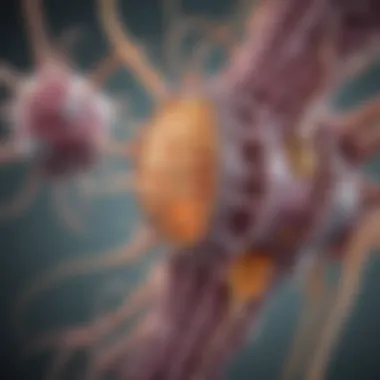Exploring Advances in Stem Cell Treatment for SMA


Intro
Spinal muscular atrophy (SMA) represents a group of genetic conditions affecting motor neurons in the spinal cord. This results in muscle weakness and atrophy, severely impacting patients' quality of life. Advances in genetic research have fueled the development of novel treatment strategies. Among these, stem cell therapy has emerged as a promising avenue for addressing the underlying issues of SMA, offering hope for improved clinical outcomes.
The advances in stem cell treatment for SMA have implications far beyond individual patient care. They prompt a reevaluation of therapeutic options and raise important ethical questions. Understanding the nuances of SMA and the evolving landscape of its treatment becomes essential for students, researchers, educators, and professionals alike. This article will delve deeply into the pathophysiology of SMA, the specifics of stem cell interventions, and the broader context of ongoing research efforts.
Overview of Spinal Muscular Atrophy
Spinal Muscular Atrophy (SMA) is a genetic disorder that significantly affects motor function. It occurs due to a deficiency in the survival motor neuron protein, which leads to the degeneration of motor neurons in the spinal cord. The implications of SMA are profound, impacting patients' ability to move and perform basic daily functions. This article aims to explore the advances in stem cell treatment for SMA, highlighting the critical relevance of understanding the disorder in the context of evolving treatment options.
A thorough examination of SMA provides insights into its types, genetic underpinnings, and the ramifications of the disease. Understanding the variations in SMA, including Type I, II, III, and IV, equips researchers and clinicians with knowledge necessary for targeted interventions. It also emphasizes the necessity for innovative therapies, such as stem cell treatment, as traditional methods often fall short in addressing the complexities of SMA.
In light of the increasing interest in stem cell research, investigating how these treatments can potentially ameliorate the effects of SMA is crucial. A focus on stem cell therapies allows for exploration into new avenues that may yield better outcomes for patients.
By delving into the overview of spinal muscular atrophy, this article aspires to lay a robust foundation for understanding the condition and the potential advancements that stem cell treatment may offer.
Current Treatment Strategies for SMA
The treatment of spinal muscular atrophy (SMA) has evolved significantly over the years. Recognizing current treatment strategies is essential to understand how they impact patient outcomes. The advancements in therapies and interventions have introduced new hope for individuals affected by this condition. With multiple approaches, some focusing on symptomatic relief while others aim for disease-modifying effects, it is crucial to explore these various methods.
Conventional Therapies
Physiotherapy
Physiotherapy plays a critical role in the management of SMA. The primary objective is to enhance mobility and prevent muscle atrophy. This approach involves tailored exercises that encourage muscle strength and flexibility. The key characteristic of physiotherapy is its individualized nature. Therapeutic activities are designed based on the patient's specific needs, which makes it a popular choice for many clinicians treating SMA.
The unique feature of physiotherapy is its non-invasive approach. It allows patients to engage actively in their care without the risks associated with surgery or medications. However, the effectiveness can vary based on the type and progression of SMA. While physiotherapy promotes physical well-being, it requires commitment from both the patient and therapist.
Nutritional Support
Nutritional support is another important aspect of treating SMA. Adequate nutrition can help maintain optimal weight, stave off malnutrition, and support overall health. The significance of proper diet cannot be understated in the management of SMA. Balanced meals rich in calories and nutrients can ensure that patients meet their energy requirements.
A key characteristic of nutritional support is its preventive role against complications. In cases where swallowing becomes impaired, specialized feeding strategies might be deployed. A unique feature of this approach is that it not only addresses physical health but also demonstrates an understanding of the patient’s quality of life. However, coordinating nutritional plans can be challenging, requiring continuous monitoring and adjustments.
Medication
Medications have revolutionized the treatment landscape for SMA. Specific drugs, like Spinraza (nusinersen), target the underlying genetic causes of SMA by enhancing the production of the survival motor neuron protein. This has made medications a cornerstone in SMA therapies, addressing both symptomatic needs and providing disease-modifying capabilities.
The key characteristic of medication is its ability to act on the genetic basis of SMA. This provides a direct benefit as opposed to purely palliative care. However, medications can have potential side effects and require careful monitoring by healthcare providers to manage any adverse effects. \nBeyond medication, other therapeutic options, such as disease-modifying interventions, are actively being explored and developed.
Gene Therapy Approaches


The introduction of gene therapy has significantly shifted the treatment paradigm for spinal muscular atrophy. This innovative approach involves correcting the genetic mutation responsible for the disease. Through viral vectors, a healthy copy of the SMN1 gene is delivered to the patient's motor neurons. Gene therapy offers the potential for lifelong benefits with a single treatment. This technique varies drastically from conventional therapies by targeting the genetic root cause of SMA.
Emerging Treatments
Emerging treatments are currently under exploration, aiming to enhance the efficacy of existing therapies or provide alternative solutions. Some trials investigate combined approaches, incorporating gene therapy with pharmacological treatments or stem cell technologies. The landscape is dynamic, and ongoing clinical studies will determine the future possibilities for SMA management.
Staying informed regarding these evolving treatments is essential for patients and healthcare providers alike. This active engagement can lead to earlier interventions and improved health outcomes, illustrating the ongoing progress in the fight against SMA.
Prolusion to Stem Cell Treatment
Stem cell treatment emerges as a promising avenue for addressing spinal muscular atrophy (SMA), a genetic disorder characterized by the degeneration of motor neurons. Understanding stem cells, their types, and their potential roles in therapy is essential. The incorporation of stem cell methodologies in SMA treatment could alter patient outcomes significantly. Stem cells possess the unique ability to differentiate into various cell types, presenting an advantage in regenerative medicine. This section explores necessary facets of stem cell treatments and sets the stage for deeper discussions on their application in SMA.
What Are Stem Cells?
Stem cells are a unique group of cells capable of developing into many different cell types in the body. They are characterized by two main traits: the ability to renew themselves through cell division and the capacity to differentiate into specialized cell types. This dual capability makes them pivotal in both basic research and therapeutic development. The versatility of stem cells underlines their potential in treating chronic conditions like SMA.
Types of Stem Cells
Embryonic Stem Cells
Embryonic stem cells (ESCs) derive from early-stage embryos and hold the key characteristic of pluripotency. This means they can develop into any cell type in the human body, offering expansive possibilities for treatment. In the context of SMA, ESCs are considered beneficial because they have the potential to regenerate damaged motor neurons effectively. However, ethical concerns arise regarding their sourcing, as obtaining ESCs involves the destruction of embryos. This raises significant moral questions which the scientific community continuously grapples with.
Adult Stem Cells
Adult stem cells are found in various tissues and organs. They possess a more limited capacity for differentiation compared to ESCs, usually leading to the formation of cell types specific to their origin. Despite this limitation, adult stem cells are popular in clinically relevant applications due to their ethical acceptance. For example, mesenchymal stem cells from bone marrow have shown potential in SMA treatment. They can modulate the immune response and enhance tissue repair, albeit they may not fully regenerate motor neurons.
Induced Pluripotent Stem Cells
Induced pluripotent stem cells (iPSCs) are adult cells reprogrammed to an embryonic-like state. This allows them to exhibit pluripotency similar to ESCs but without the associated ethical controversies. iPSCs can be generated from patient-specific cells, making them highly advantageous for personalized medicine. The primary concern, however, is the risk of tumor formation due to uncontrolled cell growth. Despite this, the advances in iPSC research remain pivotal, contributing significantly to the landscape of SMA treatment.
"The potential of stem cells lies not just in what they can do now, but what they may achieve on the horizon of medical advancements."
Research in stem cell treatments for spinal muscular atrophy continues to expand, focusing on innovative methods and therapeutic implications.
Stem Cell Treatment for SMA
Stem cell treatment for spinal muscular atrophy (SMA) represents a significant advancement in the management of this debilitating condition. It is essential to highlight the benefits and considerations of this therapy, as it may provide new hope for patients where conventional treatment fails. Unlike traditional methods that focus mainly on symptoms, stem cell therapy aims to address the underlying cause of SMA by targeting the loss of motor neurons, which is central to its pathophysiology.
Mechanisms of Action
Stem cell therapy utilizes various cellular mechanisms to combat the issues caused by SMA. Specifically, the following mechanisms can be observed in the treatment:


- Neuroprotection: Stem cells can release neurotrophic factors that help protect motor neurons from degeneration.
- Regenerative Properties: They can differentiate into motor neurons or support cells, which can replace damaged or lost cells.
- Modulation of the Immune Environment: Stem cells may help reduce inflammation in the spinal cord, further supporting neuron survival.
These mechanisms highlight the potential of stem cells not only to slow the progression of SMA but to potentially restore some functionality in affected individuals.
Clinical Trials Overview
Currently, several clinical trials are investigating the effectiveness and safety of stem cell therapies in SMA patients. The trials vary in approach, with some focusing on intrathecal delivery of stem cells while others explore systemic methods. As of now, preliminary results from these studies are promising. Many showed improvements in muscle strength and motor function among participants. Important trials to consider include the work done by AveXis, which developed Zolgensma, a gene therapy treatment that uses an adeno-associated virus to deliver the SMN1 gene. While primarily a gene therapy, it often includes stem cell components in its research.
Case Studies and Evidence
Several case studies provide substantial evidence supporting the use of stem cell therapy in SMA. Here are key findings:
- Patient A: A case study involving a Type I SMA patient treated with umbilical cord-derived stem cells showed significant improvement in motor skills within six months. The patient exhibited increased head control and the ability to sit unsupported.
- Patient B: Another study focused on Type II SMA indicated long-term benefits of intrathecal stem cell injections. After one year, patients showed increased lung function and greater physical mobility, marking a significant deviation from typical disease progression.
"Case studies suggest that stem cell therapy can lead to improvements in motor function and quality of life for SMA patients, emphasizing the importance of continued research in this area."
In summary, the therapeutic potential of stem cell treatment for SMA is both compelling and complex. It not only offers hope but also prompts further inquiry into the safety, efficacy, and ethics of such interventions.
Challenges and Limitations of Stem Cell Therapy
Stem cell therapy has emerged as a promising avenue for treating spinal muscular atrophy (SMA). However, several challenges and limitations persist that require careful consideration. Understanding these issues is crucial for researchers, clinicians, and policymakers involved in developing effective treatments for SMA patients.
Technical Challenges
Stem cell therapy poses various technical challenges that can impact outcomes. First, the process of isolating and expanding stem cells can be complex and unpredictable. Different sources of stem cells present unique difficulties. For example, embryonic stem cells offer robustness but may lead to ethical issues. Adult stem cells, while ethically preferable, often have limited proliferative capacity.
Additionally, delivering stem cells to the affected areas in the nervous system is another significant hurdle. The blood-brain barrier complicates this process. Successful delivery methods are still in development. Cell survival after transplantation also needs to be addressed. Cells must integrate into the host tissue for therapy to be effective. Failure to do so can result in minimal or no functional improvement.
Ethical Considerations
Ethical concerns are paramount in stem cell research and therapy. Issues around the source of stem cells often dominate this discourse. For instance, embryonic stem cells are derived from embryos, leading to debates about the moral implications of using human embryos for medical research. This ethical quandary creates divisions within the scientific community and society at large.
Moreover, there is the potential for exploitation. Patient consent is essential but may be difficult to obtain, especially in vulnerable populations. Explaining the risks and benefits in an understandable manner is essential for informed consent. Researchers must balance innovative exploration with ethical responsibility, ensuring the dignity and autonomy of participants is respected in trials.
Regulatory Hurdles
Regulatory obstacles also present significant barriers to the advancement of stem cell therapies. Before any treatment can be broadly adopted, it must undergo rigorous review by regulatory bodies. In many regions, stem cell therapies face stringent regulations that can slow down clinical trials and limit access.
The lack of standardization in stem cell therapies complicates regulatory processes. Each source of stem cells may have different protocols and safety profiles, making it challenging to create a one-size-fits-all approach.
Additionally, the timeline for approval can be lengthy, delaying the potential benefits for SMA patients. The balance between ensuring safety and allowing innovation is delicate. Policymakers need to establish a framework that promotes research while safeguarding patient welfare.


"The challenges in stem cell therapy for SMA are multifaceted, requiring a multidisciplinary approach to overcome them effectively."
Future Directions in SMA Research
Research in spinal muscular atrophy (SMA) is continually evolving. The exploration of future directions is essential to address existing challenges in treatment and improve patient outcomes. Innovative methodologies in stem cell therapy may hold the key to new therapeutic avenues. Developing effective interventions can significantly enhance the quality of life for SMA patients and may potentially lead to a cure.
Innovative Stem Cell Techniques
One area of focus is innovative stem cell techniques. Recent advances in the manipulation and application of stem cells are promising. Techniques such as CRISPR gene editing have shown potential in correcting genetic mutations that cause SMA.
Additionally, the use of exosomes derived from stem cells is gaining attention. Exosomes have the potential to facilitate intercellular communication and may aid in protecting motor neurons from degeneration. Research is ongoing to refine these methods, optimizing the benefits to patients.
"The development of more precise and effective stem cell treatments is critical for advancing SMA therapy."
Furthermore, combining stem cell therapy with other cutting-edge technologies, such as biomaterials, can enhance the delivery and efficacy of treatment. These materials may provide a supportive environment for stem cells, fostering better integration into the nervous system.
Combination Therapies
Another promising direction is the exploration of combination therapies. Instead of relying solely on stem cell treatment, combining different modalities could enhance effectiveness. For instance, pairing stem cell therapy with existing pharmacological treatments may provide synergistic benefits.
This approach could address multiple aspects of SMA pathology. For example:
- Gene Therapies: Utilizing gene therapy alongside stem cells could improve the overall therapeutic impact.
- Neuroprotective Agents: Combining stem cell therapy with neuroprotective drugs may slow down the progression of the disease.
By investigating how various treatments work together, researchers can develop more comprehensive strategies to manage SMA effectively.
Longitudinal Studies
Conducting longitudinal studies is vital in understanding the long-term effects of treatments on SMA patients. Such studies enable researchers to track changes over time, assess efficacy, and monitor any adverse effects that may arise with prolonged use of therapies.
These studies can provide crucial insights into patient outcomes and quality of life. This data helps in refining treatment protocols and encourages the adoption of best practices across clinical settings. Moreover, they allow researchers to evaluate the persistence of treatment effects, which is essential for establishing the durability of new therapies.
In summary, future directions in SMA research are crucial for enhancing treatment options. By focusing on innovative techniques, exploring combination therapies, and conducting thorough longitudinal studies, researchers can improve patient outcomes significantly. This ongoing commitment to research showcases the relentless pursuit of better clinical practices for those affected by SMA.
Epilogue
The exploration of spinal muscular atrophy (SMA) through the lens of stem cell treatment unveils vital insights into how emerging therapies can shape patient outcomes. This article has examined the current landscape of SMA, elaborating on the mechanisms by which stem cell therapy operates and the advancements made in recent years. Given the complexity of SMA, this topic holds significant importance not just for researchers and clinicians, but also for patients and their families who seek hope in treatment options.
Summary of Findings
Stem cell treatments offer a promising frontier in the management of SMA. They may address the underlying causes of the disease by replacing defective motor neurons and providing neuroprotective benefits. Clinical trials have yielded encouraging results, demonstrating stability and, in some cases, improvement in muscle function among participants. The evidence suggests a need for tailored approaches in stem cell applications tailored for different SMA types. As research progresses, it becomes clear that while challenges remain, the potential benefits for SMA patients are substantial.
Implications for Clinical Practice
The implications of stem cell treatment for clinical practice underscore the necessity of integrating novel therapies into standard care. Clinicians must stay informed about emerging treatments and their potential role in conjunction with existing therapies. Ethical considerations, such as patient consent and access to cutting-edge treatments, will influence how stem cell therapies are implemented in practice. Ongoing education and collaboration among healthcare professionals are critical for ensuring that patients with SMA receive the most effective evidence-based interventions possible.
The integration of innovative therapies into clinical settings must balance optimism with careful consideration of patient welfare, ethical, and regulatory aspects.















